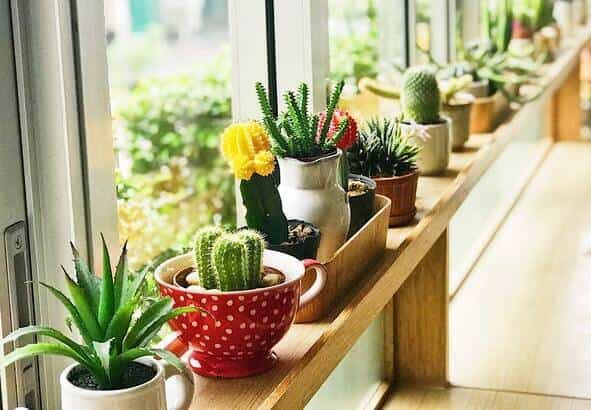Succulents are trendy plants which have extremely low needs in term of maintenance. Provide them with indirect bright sunlight, drainage friendly soil, and water them when the soil feels dry and they will be good on their own. Sunlight is an important factor behind the growth of all green plants. Succulents are no exception.
The kind of sunlight your home receives through specific directions can play a huge role in deciding the places you can grow your succulents and the kinds of succulents you need to choose in the first place.
Table of Contents
What does the East-Facing Window mean?
East Facing windows play an important role in welcoming the first soothing touches of the rising sun into your home. You can grow plants in this area of the house that loves bright sunlight of 4 to 5 hours a day.
So incidentally if you have spacious eastern windows you can explore the idea of decorating the house by placing your indoor houseplants near the east-facing window pane.
Do Succulents need to be by a Window?
Succulents love filtered indirect bright sunlight throughout the day. Most of them dislike full sun and being green plants they cannot thrive under darker conditions. Though there are some low light friendly succulents, the majority of them love to be kept near windows that get sufficient light.
The end goal is to keep them in a place that gets proper sunlight. It can be in the balcony, in the garden shade, or in the living room, as long as it gets bright light and doesn’t show signs of stretching, it will grow up to be healthy.
- You can keep them on the window pane. You can also explore the option of keeping succulents in hanging baskets in case your eastern facing windows are large enough.
- Other than this, you can simply place succulents near a table attached to the window.
So here I provide you with 8 best succulents for east-facing windows that will thrive wonderfully in those locations.
String of Pearls
Scientific Name: Senecio rowleyanus
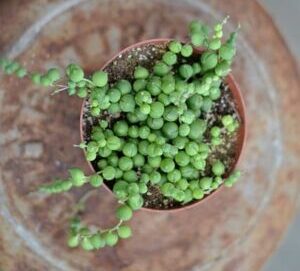
Just like the name the plant has got long tendrils of small beaded leaves that resemble pearls. Its an awesome looking succulent that will instantly turn eyes.
- It looks exactly “out of the container pouring” look like really makes it stand out.
- The best thing is it is one of the easy to care for succulents you can ever find.
Best Arrangement Suggestions for String of Pearls:
You can grow a string of pearls on hanging baskets, tabletops, wall stands, wherever you want. However, they look best when grown in hanging baskets owing to their beaded look.
How to care for the String of Pearls:
- They have low watering needs and make sure you only water when the soil feels dry to touch.
- Avoid watering the leaves and target the stem base and soil. Water absorption occurs mainly through the roots. Moist leaves can invite fungal infections.
- Trim the excess branches and leaves every few months. Do the main pruning before the start of the growing season. Cutting off plant parts also promotes better growth. You can use these plant parts for propagation as well.
- Senecio has mediocre sunlight needs and is satisfied with a few hours of bright filtered light every day.
Is the String of Pearls Toxic?
The string of Pearls is toxic to both people and animals. When ingested causes diarrhea and vomiting. So in case, you have children or pets in the house, its best to grow them as hanging baskets, out of their reach (source).
Crown-of-thorns (Yellow)
Scientific Name: Euphorbia milii

The Crown of thorns is pretty easy to care for. They can show signs of slow growth but once they mature they can live off pretty well even under neglect. They are highly sensitive to overwatering & root rot. So be careful about your watering. They are not at all cold hardy hence are popularly grown as indoor plants.
- Crown of thorns produces stunning looking red and yellow flowers depending on the species type almost all year round.
- Crown of thorns can grow up to 2 feet tall indoors and about 6 feet tall outdoors.
- The succulent has sharp blackthorns and the sticky latex can also cause irritation of the skin and eyes. So always be cautious while handling them. Wear gloves, full sleeves, and spectacles for protection.
- There are many splendid varieties of the crown of thorns available in the market. Some include Thai Giants, Brush Fire, etc.
Best Arrangement Suggestions for Crown of Thorns:
Make sure to place them at any position near the window pane, where it can get maximal sunlight.
The succulent has sharp thorns, in case you have children, put it at a place out of their reach.
How to Care for Crown of Thorns:
- Crown of Thorns grows best at room temperatures of 15 to 25 degrees Celcius and in climates low to mediocre humidity.
- These succulents need a daily dose of 3-4 hours of sunlight for optimum blooming. Sun exposure is directly related to the quality of blooming.
- They like all succulents love cactus mix soil and only water them when soil is dry.
- Trim the plant every few months to keep it in shape. They do wonderfully as bonsai succulents.
- Make sure to grow them in a compact pot which is not more than 2 inches larger than the root ball. More space means more soil which leads to more water retention, this is a big no-no for succulents.
- Will be semi-dormant in the winter so adjust your watering schedule accordingly.
Is Crown of Thorns Toxic?
Crown of thorns has sticky poisonous sap that can lead to irritation of the eyes and mouth. They also have sharp thorns that can pierce through the skin if precaution is not taken while handling (source).
Burrow”s tail
Scientific Name: Sedum morganianum
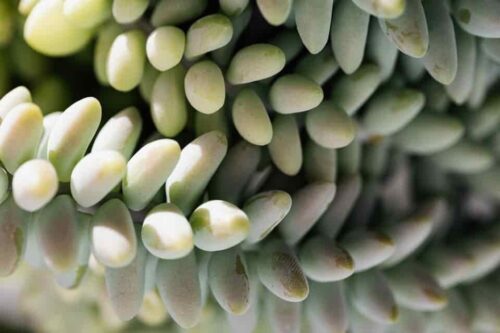
Other Name: Donkey”s Tail
- This is one of the most popular succulents out there and truly looks outstanding. Its tear-shaped leaves packed in form of long tendril outgrowths really makes it stand out.
- The plant really looks like a donkey”s tail.
Flowers are of purplish-pink to purplish-pink color which is produced in the spring. Pretty flowers at the tips of the long stems filled with greenish pointed shaped leaves make the plant look wonderful from a distance.
Best Arrangement Suggestions for String of Pearls:
- Burrow”s tail looks best in hanging baskets owing to its unique stem structure and leaf growth in cluster forms.
- You can also keep them hanging on the edge of your window. it will look outstanding from outside.
How to care for Sedum morganianum:
- Sedums love bright sunlight for 4 to 6 hours a day. They can put up with partial shade but do not like darker rooms. Hence the eastern facing windows suit them great.
- Loves drainage friendly soil rich in inorganic materials. Ideally if possible have drainage holes in containers and then place them over some other container or tray so that you can get rid of excess water.
- Trim the branches from time to time to get it in shape.
- Leaves fall off pretty easily so you can use the healthy-looking ones for propagation.
- They can put up with pretty low temperatures of below 10 degrees Celcius however its best to keep them under warm and comfy conditions.
- Water only when soil is dry.
- If the succulent outgrows its container after the first year, consider repotting it in a new pot a bit larger than the previous one.
Is Sedum morganianum toxic?
Sedum morganianum is regarded as non-toxic for pets and children. When ingested they can cause mild symptoms that can be easily treated (source).
Jade Plant
Scientific Name: Crassula ovata
Other Names: Money plant

Jade plants are very simple plants to grow. This plant is known to bring in good charm hence the name money plant.
The unique shape of the leaves gives the plant a distinguished look. This succulent can grow well on its own and hence are commonly grown in offices and other workplaces. Produces pink flowers in summer if gets enough sun.
Best Arrangement Suggestions for Jade Plant:
- On desks
- Coffee Table
- Table Top
- Window Pane
- Wall stand
How to care for Jade Plant:
- The Jade plant has fleshy leaves so they do a really great job of storing water. So make sure never to overwater the plant. They only need watering when the soil is truly dry.
- Grows slowly so does well in medium-sized pots.
- They can grow well under10 to 23 degrees Celcius. So make sure they dn’t get exposed to higher or lower temperatures.
- Jade plants love a lot of daily exposure to light. Make sure it gets enough sun otherwise it can grow leggy.
Is Jade Plant Toxic?
Jade plant is toxic to dogs, cats, horses, and other pets and causes vomiting along with other stomach related problems. Keep it out of reach of children (source).
Panda Plant
Scientific Name: Kalanchoe tomentosa
Other Names: Chocolate Soldier
Panda plants have extremely thick leaves and are covered in think hairs which provide the plant with a soft texture, unlike other succulents. The surface hairs help in lessening water loss and in deflecting heat. They grow only up to 1 to 2 feet long indoors.
The thick leaves allow the plant to store water for a long time hence can put up with irregular watering. The brownish rust like edges of the leaves gives them a distinct fur-like look. They generally don’t bloom especially indoors.
Best Arrangement Suggestions for Panda Plant:
They look lovely on hanging containers! They also look beautiful on shelves or on tables.
How to care for Panda Plant:
- They can easily put up with medium to low light conditions. However, while growing they love So place them accordingly.
- Have them placed on a cactus mix soil with holes at pot bottom.
- Watering frequently is not needed. Only water when the potting soil is dry and give the pant a good drenching.
- Panda plants like a little bit of humidity in the air. Under proper conditions, these plants can go onto live for many years.
- The optimal temperature of growth is 15 to 25 degrees Celcius.
- They can be easily propagated through their leaves.
Is Panda Plant toxic?
Panda plant is toxic to children pets as when ingested it causes serious irritation in the mouth along with vomiting & diarrhea (source).
Woodland Stonecrop
Scientific Name: Sedum ternatum
It is a native plant from North America and Produces charming white flowers during the hotter months. The blooming and growing phase starts from spring and lasts till late summer. The leaves are small yet fleshy.
The succulents need little care on a regular basis so perfect if you have a busy life. They can grow up to 5 to 6 inches long. However, the width of the plant is really extraordinary. It can range up to 10 inches.
They can handle harsh growing conditions and is highly adaptable to the conditions. They are pleasant looking succulents which will provide your room with a touch of coziness.
Best Arrangement Suggestions for woodland stonecrop:
You can grow this plant on dedicated tabletops. It can be quite wide so choose the spot accordingly. They look great beside sofas and in living rooms. They also pair well with other succulents so you can experiment a bit.
How to care for woodland stonecrop:
- Can adapt with direct full sun as well as indirect sun off eastern windows. As mentioned earlier they are highly adaptive.
- Once they are properly grown they can put up with drought for weeks. However, always water them when the soil is dry.
- Always use well-draining soil. You should remove the worn-out plant parts from time to time. Other than this once matured the succulent can grow quite well on its own with basic care.
Snake Plant
Scientific Name: Sanseveria trifasciata
Other Names: mother-in-law’s tongue
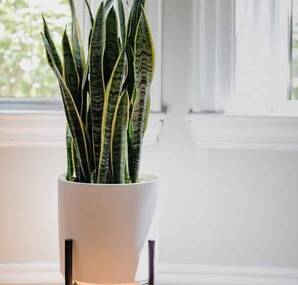
Snake plants are regarded as one of the best air purifying succulents out there. They help in removing toxins like formaldehyde, toluene, benzene, etc from the air.
- They have huge splashy leaves that stand really tall and gives the plant a distinguishable look. Snake plants produce greenish-white flowers in flowering seasons.
Best Arrangement Suggestions for Snake Plant:
On the :
- Tabletop
- Coffee table
- Office desk
- Windowpane.
How to care for Snake Plant:
- Place it in a cactus mix and have drainage holes at the bottom of the pot.
- Water only when the soil is dry. Snake plants are prone to fungal infections so be very cautious of watering them. They can put up with drought to some extent but not overwatering. When watering leaves the leaves out.
- Use a succulent friendly water sprinkler for better control and aim to drench the soil. Never mist snake plants.
- Snake plants are highly low maintenance and they can put up with low to mediocre sunlight on a regular basis.
Is Snake Plant toxic?
Snake plants when ingested is toxic for children and pets including cats, dogs. Causes serious irritation in the stomach and leads to nausea, vomiting, stomach problems (source).
Medicinal Aloe
Scientific Name: Aloe Vera
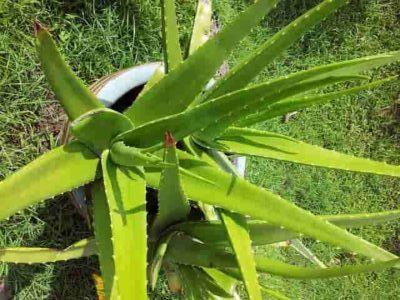
- It’s one of the best plants to grow indoors especially if you are just getting started with gardening.
- They have beautiful looking leaves that look stunning from a distance.
- Aloe does not do well under full sun conditions and are ideal plants to be grown in offices and even bathrooms that have east faced windows.
- The gel obtained from the Aloe leaves can be used for treating skin burns or for just nourishing the skin and hair better. However, the ingestion of aloe gel is never recommended without supervision as it can be extremely fatal (source).
Best Arrangement Suggestions for Aloe vera:
- It is kind of a plant that can grow anywhere.
You can grow them on the tabletop, on the wall stand, on the coffee table, office desk, or just keep them on the window pane.
How to care for Aloe vera:
- Aloe vera can keep with low light conditions but if it does not get sufficient light it can be leggy.
- They can put up with neglect of watering for weeks owing to their juicy leaves. However this should never be the case, always water them when the soil feels dry.
- Avoid watering the leaves and go for the soil.
- They are extremely easy to grow and have very few needs apart from a proper drainage friendly soil, sufficient indirect sunlight, and watering once in 5-10 days depending upon the soil dryness.
- They love temperatures of 13 to 25 degrees Celcius. They cannot tolerate cold as well as hot full sun.
- You can use the newly growing baby leaves for propagation, be sure to keep the base intact.
Is Aloe vera toxic?
The aloe vera plant is considered highly toxic owing to the presence of saponins. When ingested by children or pets it can cause severe stomach issues including vomiting, diarrhea, nausea (source).
Basic Caring Tips for all the Succulents for East-facing windows
Choosing the right Planter
- Go for pots with drainage holes at the bottom. Succulents can only thrive better if you have superior drainage in place.
- Drainage hoes ensure the water gets drained off fast and the soil becomes dry fast. In case you are growing them inside, use trays or plates and keep the plant over that. Get rid of the water after watering.
- Try using terra cotta pots as they absorb water better.
- You can grow succulents in glass containers or other containers without holes but you need to take extra precautions in place for that.
Refer these posts for growing succulents in pots without drainage holes:
- Can you plant Succulents in Mason jars or Glass Containers?
- How to Water Succulents Without Drainage
- Do Cactus Need Drainage Holes? (& How to Grow them Without Holes)
The Fundamental Need for all succulents: Drainage friendly Soil
Succulents cannot survive without drainage friendly soil. They can cope with low light, keep up with understanding but not with improper soil.

So always use cactus mix soil for growing succulents. You can make your own soil at home if you want by mixing equal amounts of inorganic components like coarse sand, volcanic rocks, pumice with potting soil. Refer to this guide for preparing succulent soil at home.
Never Overwater Succulents
- Succulents cannot tolerate overwatering as they are not prone to that in their habitats. So always make sure the soil is dry before watering. Use a moisture meter for being sure. Overwatering can lead to root rot and can kill your plant slowly.
Fertilization
- Use a well-balanced fertilizer preferably low in nitrogen and dilute it several times before use. Apply once a year before the start of the growing season.
- In case you wanna provide the soil with extra nutrition from time to time throughout the year, you can use Epsom salt diluted several times in water as it acts as a great source of magnesium and sulfate.
Can Succulents Grow in the East-Facing Window without any issues?
For windows located on the eastern sides, Low to mediocre light-loving succulents is the best. These succulents remain more than happy with few hours of the fresh morning sun and the early afternoon sun.
Succulents needing less than 5 to 6 hours of bright indirect light every day will thrive really well on eastern facing windows. (Provided there are not huge buildings just in front as the sun will get blocked)
- Succulents that typically thrive best with about 6 to 7 hours of light exposure through the windows will grow best if kept in the balcony or near the south-facing windows.
So select your succulents accordingly. However, there is no hard and fast rule that you can only keep low light to mediocre light friendly succulents in the eastern windows. Succulents are highly adaptive plants and you can always experiment from time to time.
- Also, you can roughly calculate the number of hours your east-facing windows get proper sun before deciding which succulents to bring home. If its above 4 hours then it’s great you can literally opt for any variety of succulents. Or else you can always experiment with your plants.
FAQ:
Do East-Facing Windows get Sun?
East facing windows gets the first touch of sunlight right after dawn. There is little to no difference in the quality of sunlight received through the east and the north. Only the sunlight obtained through eastern windows lasts for a shorter while and is much less intense.
You can keep your pots of succulents on the window panes and let them enjoy the soft touch of the first rays of the day.
What facing window is best for succulents?
Most succulents love indirect filtered light for 4 to 6 hours a day, so for them, the south-facing and the east-facing windows are the best. As the sun follows a slight southern east to west motion on the sky from the dawn to the evening, the south-facing windows get the maximal light followed by the eastern ones.
- However, this is no hard and fast rule. There are variables everywhere. If your south is totally blocked due to construction there is no use keeping succulents on that side.
The end goal is to find out which regions of your house get the best sunlight and then growing succulents in those places. There are many low light friendly succulents that can grow on western or northern facing windows as well with ease. So where should you keep your succulent depends on your house and the succulent type.
Conclusion
As long as the succulents get good light, you can grow them anywhere. However east-facing window is known to get the fresh morning sun which is extremely good for plants that like the mediocre sun. These 9 succulents can thrive really well with basic care on eastern windows.
What succulents do you currently grow on your eastern windows? Do you have extra suggestions for this list? Please comment below to let me know!
Also Read:
